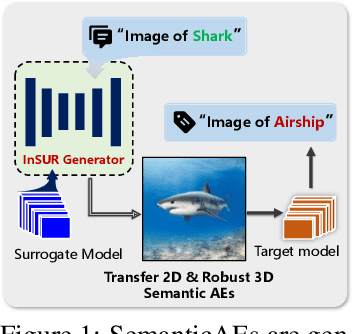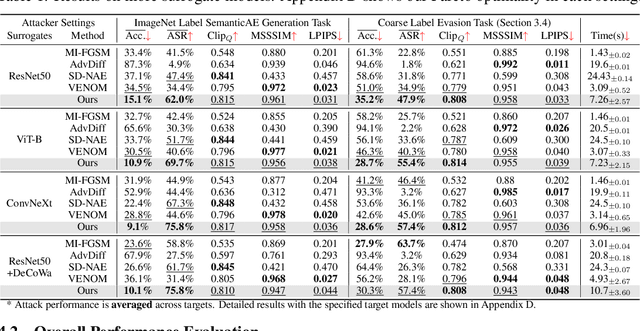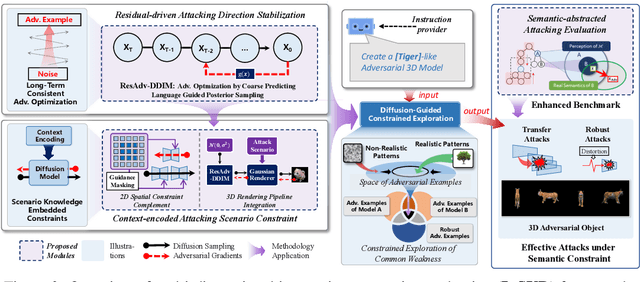Haolin Li
Exploring Semantic-constrained Adversarial Example with Instruction Uncertainty Reduction
Oct 27, 2025



Abstract:Recently, semantically constrained adversarial examples (SemanticAE), which are directly generated from natural language instructions, have become a promising avenue for future research due to their flexible attacking forms. To generate SemanticAEs, current methods fall short of satisfactory attacking ability as the key underlying factors of semantic uncertainty in human instructions, such as referring diversity, descriptive incompleteness, and boundary ambiguity, have not been fully investigated. To tackle the issues, this paper develops a multi-dimensional instruction uncertainty reduction (InSUR) framework to generate more satisfactory SemanticAE, i.e., transferable, adaptive, and effective. Specifically, in the dimension of the sampling method, we propose the residual-driven attacking direction stabilization to alleviate the unstable adversarial optimization caused by the diversity of language references. By coarsely predicting the language-guided sampling process, the optimization process will be stabilized by the designed ResAdv-DDIM sampler, therefore releasing the transferable and robust adversarial capability of multi-step diffusion models. In task modeling, we propose the context-encoded attacking scenario constraint to supplement the missing knowledge from incomplete human instructions. Guidance masking and renderer integration are proposed to regulate the constraints of 2D/3D SemanticAE, activating stronger scenario-adapted attacks. Moreover, in the dimension of generator evaluation, we propose the semantic-abstracted attacking evaluation enhancement by clarifying the evaluation boundary, facilitating the development of more effective SemanticAE generators. Extensive experiments demonstrate the superiority of the transfer attack performance of InSUR. Moreover, we realize the reference-free generation of semantically constrained 3D adversarial examples for the first time.
LiRA: Linguistic Robust Anchoring for Cross-lingual Large Language Models
Oct 16, 2025Abstract:As large language models (LLMs) rapidly advance, performance on high-resource languages (e.g., English, Chinese) is nearing saturation, yet remains substantially lower for low-resource languages (e.g., Urdu, Thai) due to limited training data, machine-translation noise, and unstable cross-lingual alignment. We introduce LiRA (Linguistic Robust Anchoring for Large Language Models), a training framework that robustly improves cross-lingual representations under low-resource conditions while jointly strengthening retrieval and reasoning. LiRA comprises two modules: (i) Arca (Anchored Representation Composition Architecture), which anchors low-resource languages to an English semantic space via anchor-based alignment and multi-agent collaborative encoding, preserving geometric stability in a shared embedding space; and (ii) LaSR (Language-coupled Semantic Reasoner), which adds a language-aware lightweight reasoning head with consistency regularization on top of Arca's multilingual representations, unifying the training objective to enhance cross-lingual understanding, retrieval, and reasoning robustness. We further construct and release a multilingual product retrieval dataset covering five Southeast Asian and two South Asian languages. Experiments across low-resource benchmarks (cross-lingual retrieval, semantic similarity, and reasoning) show consistent gains and robustness under few-shot and noise-amplified settings; ablations validate the contribution of both Arca and LaSR. Code will be released on GitHub and the dataset on Hugging Face.
Physics-informed Neural Network Predictive Control for Quadruped Locomotion
Mar 10, 2025Abstract:This study introduces a unified control framework that addresses the challenge of precise quadruped locomotion with unknown payloads, named as online payload identification-based physics-informed neural network predictive control (OPI-PINNPC). By integrating online payload identification with physics-informed neural networks (PINNs), our approach embeds identified mass parameters directly into the neural network's loss function, ensuring physical consistency while adapting to changing load conditions. The physics-constrained neural representation serves as an efficient surrogate model within our nonlinear model predictive controller, enabling real-time optimization despite the complex dynamics of legged locomotion. Experimental validation on our quadruped robot platform demonstrates 35% improvement in position and orientation tracking accuracy across diverse payload conditions (25-100 kg), with substantially faster convergence compared to previous adaptive control methods. Our framework provides a adaptive solution for maintaining locomotion performance under variable payload conditions without sacrificing computational efficiency.
Finite-PINN: A Physics-Informed Neural Network Architecture for Solving Solid Mechanics Problems with General Geometries
Dec 12, 2024



Abstract:PINN models have demonstrated impressive capabilities in addressing fluid PDE problems, and their potential in solid mechanics is beginning to emerge. This study identifies two key challenges when using PINN to solve general solid mechanics problems. These challenges become evident when comparing the limitations of PINN with the well-established numerical methods commonly used in solid mechanics, such as the finite element method (FEM). Specifically: a) PINN models generate solutions over an infinite domain, which conflicts with the finite boundaries typical of most solid structures; and b) the solution space utilised by PINN is Euclidean, which is inadequate for addressing the complex geometries often present in solid structures. This work proposes a PINN architecture used for general solid mechanics problems, termed the Finite-PINN model. The proposed model aims to effectively address these two challenges while preserving as much of the original implementation of PINN as possible. The unique architecture of the Finite-PINN model addresses these challenges by separating the approximation of stress and displacement fields, and by transforming the solution space from the traditional Euclidean space to a Euclidean-topological joint space. Several case studies presented in this paper demonstrate that the Finite-PINN model provides satisfactory results for a variety of problem types, including both forward and inverse problems, in both 2D and 3D contexts. The developed Finite-PINN model offers a promising tool for addressing general solid mechanics problems, particularly those not yet well-explored in current research.
Graph Sampling for Scalable and Expressive Graph Neural Networks on Homophilic Graphs
Oct 22, 2024Abstract:Graph Neural Networks (GNNs) excel in many graph machine learning tasks but face challenges when scaling to large networks. GNN transferability allows training on smaller graphs and applying the model to larger ones, but existing methods often rely on random subsampling, leading to disconnected subgraphs and reduced model expressivity. We propose a novel graph sampling algorithm that leverages feature homophily to preserve graph structure. By minimizing the trace of the data correlation matrix, our method better preserves the graph Laplacian's rank than random sampling while achieving lower complexity than spectral methods. Experiments on citation networks show improved performance in preserving graph rank and GNN transferability compared to random sampling.
LoRKD: Low-Rank Knowledge Decomposition for Medical Foundation Models
Sep 29, 2024



Abstract:The widespread adoption of large-scale pre-training techniques has significantly advanced the development of medical foundation models, enabling them to serve as versatile tools across a broad range of medical tasks. However, despite their strong generalization capabilities, medical foundation models pre-trained on large-scale datasets tend to suffer from domain gaps between heterogeneous data, leading to suboptimal performance on specific tasks compared to specialist models, as evidenced by previous studies. In this paper, we explore a new perspective called "Knowledge Decomposition" to improve the performance on specific medical tasks, which deconstructs the foundation model into multiple lightweight expert models, each dedicated to a particular anatomical region, with the aim of enhancing specialization and simultaneously reducing resource consumption. To accomplish the above objective, we propose a novel framework named Low-Rank Knowledge Decomposition (LoRKD), which explicitly separates gradients from different tasks by incorporating low-rank expert modules and efficient knowledge separation convolution. The low-rank expert modules resolve gradient conflicts between heterogeneous data from different anatomical regions, providing strong specialization at lower costs. The efficient knowledge separation convolution significantly improves algorithm efficiency by achieving knowledge separation within a single forward propagation. Extensive experimental results on segmentation and classification tasks demonstrate that our decomposed models not only achieve state-of-the-art performance but also exhibit superior transferability on downstream tasks, even surpassing the original foundation models in task-specific evaluations. The code is available at here.
A MEMS-based terahertz broadband beam steering technique
Sep 06, 2024Abstract:A multi-level tunable reflection array wide-angle beam scanning method is proposed to address the limited bandwidth and small scanning angle issues of current terahertz beam scanning technology. In this method, a focusing lens and its array are used to achieve terahertz wave spatial beam control, and MEMS mirrors and their arrays are used to achieve wide-angle beam scanning. The 1~3 order terahertz MEMS beam scanning system designed based on this method can extend the mechanical scanning angle of MEMS mirrors by 2~6 times, when tested and verified using an electromagnetic MEMS mirror with a 7mm optical aperture and a scanning angle of 15{\deg} and a D-band terahertz signal source. The experiment shows that the operating bandwidth of the first-order terahertz MEMS beam scanning system is better than 40GHz, the continuous beam scanning angle is about 30{\deg}, the continuous beam scanning cycle response time is about 1.1ms, and the antenna gain is better than 15dBi at 160GHz. This method has been validated for its large bandwidth and scalable scanning angle, and has potential application prospects in terahertz dynamic communication, detection radar, scanning imaging, and other fields.
Reprogramming Distillation for Medical Foundation Models
Jul 09, 2024Abstract:Medical foundation models pre-trained on large-scale datasets have demonstrated powerful versatile capabilities for various tasks. However, due to the gap between pre-training tasks (or modalities) and downstream tasks (or modalities), the real-world computation and speed constraints, it might not be straightforward to apply medical foundation models in the downstream scenarios. Previous methods, such as parameter efficient fine-tuning (PEFT) methods and knowledge distillation (KD) methods, are unable to simultaneously address the task (or modality) inconsistency and achieve personalized lightweight deployment under diverse real-world demands. To address the above issues, we propose a novel framework called Reprogramming Distillation (RD). On one hand, RD reprograms the original feature space of the foundation model so that it is more relevant to downstream scenarios, aligning tasks and modalities. On the other hand, through a co-training mechanism and a shared classifier, connections are established between the reprogrammed knowledge and the knowledge of student models, ensuring that the reprogrammed feature space can be smoothly mimic by the student model of different structures. Further, to reduce the randomness under different training conditions, we design a Centered Kernel Alignment (CKA) distillation to promote robust knowledge transfer. Empirically, we show that on extensive datasets, RD consistently achieve superior performance compared with previous PEFT and KD methods.
Exploring Training on Heterogeneous Data with Mixture of Low-rank Adapters
Jun 14, 2024Abstract:Training a unified model to take multiple targets into account is a trend towards artificial general intelligence. However, how to efficiently mitigate the training conflicts among heterogeneous data collected from different domains or tasks remains under-explored. In this study, we explore to leverage Mixture of Low-rank Adapters (MoLA) to mitigate conflicts in heterogeneous data training, which requires to jointly train the multiple low-rank adapters and their shared backbone. Specifically, we introduce two variants of MoLA, namely, MoLA-Grad and MoLA-Router, to respectively handle the target-aware and target-agnostic scenarios during inference. The former uses task identifiers to assign personalized low-rank adapters to each task, disentangling task-specific knowledge towards their adapters, thereby mitigating heterogeneity conflicts. The latter uses a novel Task-wise Decorrelation (TwD) loss to intervene the router to learn oriented weight combinations of adapters to homogeneous tasks, achieving similar effects. We conduct comprehensive experiments to verify the superiority of MoLA over previous state-of-the-art methods and present in-depth analysis on its working mechanism. Source code is available at: https://github.com/MediaBrain-SJTU/MoLA
3D-HGS: 3D Half-Gaussian Splatting
Jun 04, 2024Abstract:Photo-realistic 3D Reconstruction is a fundamental problem in 3D computer vision. This domain has seen considerable advancements owing to the advent of recent neural rendering techniques. These techniques predominantly aim to focus on learning volumetric representations of 3D scenes and refining these representations via loss functions derived from rendering. Among these, 3D Gaussian Splatting (3D-GS) has emerged as a significant method, surpassing Neural Radiance Fields (NeRFs). 3D-GS uses parameterized 3D Gaussians for modeling both spatial locations and color information, combined with a tile-based fast rendering technique. Despite its superior rendering performance and speed, the use of 3D Gaussian kernels has inherent limitations in accurately representing discontinuous functions, notably at edges and corners for shape discontinuities, and across varying textures for color discontinuities. To address this problem, we propose to employ 3D Half-Gaussian (3D-HGS) kernels, which can be used as a plug-and-play kernel. Our experiments demonstrate their capability to improve the performance of current 3D-GS related methods and achieve state-of-the-art rendering performance on various datasets without compromising rendering speed.
 Add to Chrome
Add to Chrome Add to Firefox
Add to Firefox Add to Edge
Add to Edge